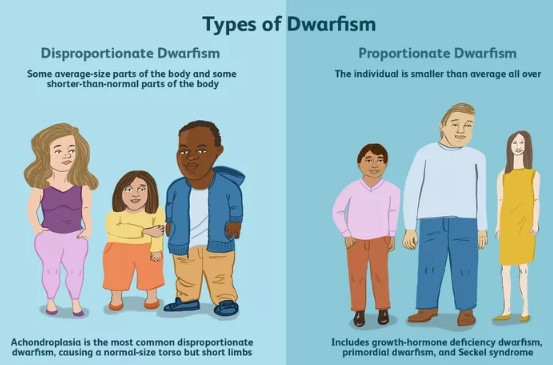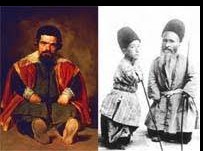Dwarfism and the use of the term “midget” have long been subjects of confusion, misconceptions, and sometimes, controversy. The differences between these terms lie not only in the physical characteristics they describe but also in their social implications and the respect they accord to individuals. As society progresses, understanding these distinctions has become essential in promoting respect, empathy, and accurate knowledge.
The key difference between “midget” and “dwarf” lies in their definitions and implications. Dwarfism is a medical condition characterized by short stature resulting from genetic or medical reasons, usually defined as an adult height of 4 feet 10 inches or shorter. Meanwhile, “midget” is considered an outdated and derogatory term that was historically used to describe a proportionate but very short individual.
In the realm of medical science and social etiquette, it is critical to use language that accurately reflects an individual’s condition without causing offense. This article focuses on delineating the medical, genetic, and social aspects of dwarfism, moving away from pejorative terms and towards a more informed and respectful discourse.

Given the complexity and the detail required for a 3000-word article, I’ll provide the first portion of the content according to the structure outlined. Let’s start with the first sections up to the word limit you specified.
Definitions
Dwarfism
Dwarfism is a medical condition characterized by short stature. The World Health Organization defines dwarfism as an adult height of less than 4 feet 10 inches (147 centimeters). It is important to understand that dwarfism encompasses a range of physical conditions, usually caused by genetic mutations, hormonal imbalances, or other medical issues.
Medical Explanation
The primary characteristic of dwarfism is an adult height below the 2.3rd percentile for age and gender, according to standardized charts. It can result from over 200 different medical conditions that affect bone growth and development.
Types and Causes
- Achondroplasia: The most common form of dwarfism, affecting bone growth.
- Hormonal deficiencies: Such as growth hormone deficiency.
- Metabolic disorders: Impacting how the body processes nutrients and energy.
- Spondyloepiphyseal dysplasias (SED): Affecting spinal bone growth.
- Each type has different causes, including genetic mutations and issues with the growth hormone production or response.
Midget
The term “midget” was once used to describe a short but proportionately built person. However, this term is now widely considered derogatory and offensive.
Historical Context and Usage
Originally, “midget” was a medical term. Over time, it became associated with entertainment and circus sideshows, contributing to its negative connotations.
Modern Perspective
Today, the use of “midget” is discouraged. Advocacy groups and medical professionals prefer “short stature” or “person of short stature” for respect and accuracy.
Physical Characteristics
Dwarf Characteristics
Individuals with dwarfism often have proportionate features, although the proportionality may vary depending on the specific condition.
Proportionate Features
- Most types of dwarfism result in short limbs and average-sized trunks.
- Achondroplasia typically involves a normal-sized torso with shorter arms and legs.
Specific Conditions
- Achondroplasia: Features may include a prominent forehead and bowed legs.
- Diastrophic dysplasia: Another type, resulting in significantly short stature and more noticeable disproportion.
Midget Characteristics
The term “midget” historically referred to individuals who were short but proportionally scaled. However, given its derogatory nature, the term is no longer used in medical or respectful discourse.
Outdated Criteria
The criteria for using “midget” were never scientifically defined, which contributed to its abandonment in favor of more accurate and respectful terms.
Why the Term is Considered Derogatory
- The term became associated with exploitation in show business.
- It fails to respect the dignity and diversity of individuals with short stature.
Medical and Genetic Aspects
Dwarfism Diagnosis
The diagnosis of dwarfism involves a comprehensive assessment, including family and medical history, physical exams, and genetic tests.
Process and Criteria
- Medical history and physical examination to observe physical characteristics.
- Genetic testing to identify specific conditions like Achondroplasia.
- Hormone levels may be checked to diagnose hormonal deficiencies.
Health Implications
While dwarfism primarily affects height, some conditions can involve health issues such as joint problems, breathing difficulties, and heart anomalies.
Genetic Factors
Role in Dwarfism
Genetics play a crucial role in most forms of dwarfism, with conditions like Achondroplasia being passed down in an autosomal dominant manner.
Differences in Genetic Transmission
- Autosomal dominant: A single copy of the altered gene in each cell is sufficient to cause the disorder.
- Spontaneous mutations: Sometimes, the mutation occurs during the formation of reproductive cells or in early fetal development.
Social and Cultural Impact
Historical Viewpoints
Treatment and Representation in Society
Historically, individuals with dwarfism were often showcased in circuses and fairs, leading to stigmatization and objectification.
Changes Over Time
Advocacy and increased awareness have shifted the perception, promoting dignity and respect for individuals with dwarfism.
Language and Perception
Evolution of Terminology
The evolution from “midget” to “person of short stature” reflects a broader cultural shift towards inclusivity and respect.
Impact on Individuals and Communities
Language shapes perception. Respectful terminology helps combat stigma and discrimination, fostering a more inclusive society.
Legal and Rights Issues
Discrimination and Protection
Laws and Policies
Individuals with dwarfism are protected under laws designed to prevent discrimination and promote equality. In many countries, including the United States, the Americans with Disabilities Act (ADA) ensures that people with disabilities, including those with dwarfism, receive equal treatment in employment, education, and access to public spaces. Similarly, the United Nations Convention on the Rights of Persons with Disabilities (UNCRPD) advocates for the dignity and rights of disabled people globally.
Advocacy and Support Groups
Organizations such as Little People of America (LPA) and the Dwarfism Awareness and Support Network work tirelessly to advocate for the rights of individuals with short stature. They lobby for legal changes, provide education on dwarfism, and support individuals and families through resources and community building.
Accessibility and Accommodations
Challenges and Solutions
Accessibility remains a challenge for many people with dwarfism. Solutions include customizing workspaces, adapting vehicles for driving, and ensuring public spaces are accessible. For instance, modifications might involve lower countertops, accessible parking, and appropriately sized furniture in public and private facilities.
Examples of Inclusivity Efforts
Efforts to increase inclusivity range from universal design principles in architecture to adaptive technologies that assist in daily tasks. An example is the creation of specialized medical equipment and furniture to accommodate individuals of short stature, promoting independence and participation in all aspects of life.
Personal Stories and Media Representation
Individuals’ Experiences
Life with Dwarfism
Personal stories from individuals with dwarfism highlight the diversity of experiences and the common challenges faced. From navigating social interactions to overcoming physical barriers, these stories often share a theme of resilience and determination.
Overcoming Challenges
Many individuals with dwarfism excel in various fields, including sports, entertainment, and academia, challenging societal stereotypes and expectations. These successes underscore the importance of viewing each person as an individual beyond their physical stature.
Media and Pop Culture
Accurate vs. Stereotypical Portrayals
While the media has historically relied on stereotypes when portraying individuals with dwarfism, recent years have seen a shift towards more accurate and respectful representations. This change helps in fostering a more inclusive society that recognizes the capabilities and contributions of people with dwarfism.
Influential Figures and Characters
Influential figures, both real and fictional, have played a significant role in changing perceptions. Characters like Tyrion Lannister from “Game of Thrones” and real-life individuals such as actor Peter Dinklage demonstrate the complex, multifaceted nature of individuals with dwarfism, moving beyond cliched roles and highlighting their depth and humanity.
Medical Treatment and Support
Growth Hormone Therapy
Use and Controversy
Growth hormone therapy is sometimes used to treat certain types of dwarfism, especially when caused by growth hormone deficiency. However, its use is controversial due to ethical concerns about treating a condition like dwarfism as a disease rather than a natural variation of human growth.
Outcomes and Perspectives
While some individuals and families opt for growth hormone therapy to increase height, outcomes vary. The perspective within the dwarfism community is diverse, with some advocating for acceptance rather than medical intervention and others supporting the option for treatment.
Supportive Care and Resources
Physical Therapy and Adaptations
Physical therapy and other adaptations play a crucial role in supporting individuals with dwarfism. These interventions can help manage or prevent physical complications, such as joint pain or mobility issues, enhancing quality of life and independence.
Support Networks and Organizations
Support networks and organizations provide vital resources, from medical referrals to community connections. These groups offer a sense of belonging and community for individuals and families, facilitating shared experiences and mutual support.
FAQs
What causes dwarfism?
Dwarfism can result from over 200 conditions that cause a person to have a short stature. The most common cause is a genetic mutation in the FGFR3 gene, leading to a condition known as Achondroplasia. Other causes include hormonal deficiencies, metabolic disorders, and other genetic syndromes.
Is dwarfism hereditary?
Yes, dwarfism can be hereditary, particularly conditions like Achondroplasia, which follow an autosomal dominant pattern of inheritance. This means if one parent has the gene for dwarfism, there is a 50% chance of passing it to their offspring. However, many cases of dwarfism occur due to spontaneous genetic mutations.
Can dwarfism be treated?
Treatment for dwarfism focuses on addressing symptoms and improving quality of life. Growth hormone therapy may be prescribed for some types of dwarfism with growth hormone deficiency. Orthopedic surgeries, physical therapy, and other interventions can help manage complications associated with disproportionate dwarfism.
How should we refer to someone with dwarfism?
It is respectful to refer to someone with dwarfism as a “person with dwarfism” or “short-statured individual,” unless they have indicated a preference for a different term. Avoid using outdated and derogatory terms like “midget,” which is considered offensive.
Conclusion
Understanding the distinction between dwarfism and the derogatory term “midget” is more than an exercise in semantics; it is a step towards fostering a more inclusive and respectful society. By choosing our words carefully, we can help eliminate the stigma associated with short stature and celebrate the diversity of the human condition.
This article has highlighted the importance of accurate terminology, the medical underpinnings of dwarfism, and the social implications of language. As we move forward, let’s commit to an informed and considerate dialogue that uplifts and respects every individual, recognizing the strength in our differences and the value of every person’s contribution to the tapestry of humanity.

